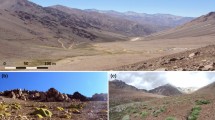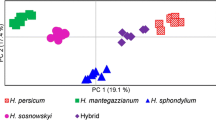Abstract
In the megadiverse forests of Southeast Asia, hundreds of timber species are economically important but the population genetics of only a few taxa are known. Cross-specific amplification of microsatellite loci among closely related taxa could enhance our ability to study and manage previously unstudied species. We successfully utilized STMS markers in Shorea platyclados, originally developed for Shorea curtisii. The six primer pairs we tried successfully produced PCR products of expected sizes. The number of alleles observed ranged from 10 to 14 and an average of 12 alleles were detected per locus. A high expected and observed heterozygosity was observed and it ranges from 0.718 to 0.827 among all populations across all six loci tested. Microsatellite DNA markers are highly polymorphic, co-dominant, reproducible, and amenable to high throughput genetic analyses. Overall, the cross-specific amplification of microsatellite loci appears to be complicated by numerous factors. While the approach may be effective for local management and conservation of poorly known species, the results must be carefully interpreted.


Similar content being viewed by others
References
Adams RI, Brown KM, Hamilton MB (2004) The impact of microsatellite electromorph size homoplasy on multilocus population structure estimates in a tropical tree (Corythophora alta) and an anadromous fish (Morone saxatilis). Mol Ecol 13:2579–2588
Baillie IC, Ashton PS, Court MN, Anderson JAR, Fitzpatrick EA et al (1987) Site characteristics and the distribution of tree species in mixed dipterocarp forest on tertiary sediments in central Sarawak, Malaysia. J Trop Ecol 3:201–220
Barbara T, Palma-Silva C, Paggi GM, Bered F, Fay MF, Lexer C (2007) Cross-species transfer of nuclear microsatellite markers: potential and limitations. Mol Ecol 16:3759–3767
Brookfield JFY (1996) A simple new method for estimating null allele frequency from heterozygote deficiency. Mol Ecol 5:453–455
Burgess PF (1966) Timbers of Sabah. Forest Department, Sandakan, pp 355–361
Byrne M, Marquez Garcia MI, Uren T, Smith DS, Moran GF (1996) Conservation and genetic diversity of microsatellite loci in the genus Eucalyptus. Aust J Bot 44:331–341
Cannon CH, Peart DR, Leighton M, Kartawinata K (1994) The structure of lowland rainforest after selective logging in West Kalimantan, Indonesia. For Ecol Manag 67:49–68
Charlesworth B, Sniegowski P, Stephan W (1994) The evolutionary dynamics of repetitive DNA in eukaryotes. Nature 371:215–220
Curtu AL, Finkeldey R, Gailing O (2004) Comparative sequencing of a microsatellite locus reveals size homoplasy within and between European oak species (Quercus spp.). Plant Mol Biol Rep 22:339–346
Dettman JR, Taylor JW (2004) Mutation and evolution of microsatellite loci in neurospora. Genetics 168:1231–1248
Doyle JJ, Doyle JL (1987) Rapid DNA isolation procedure for small quantities of fresh leaf tissue. Phytochem Bull 19:11–15
Gupta PK, Balyan IS, Sharma PC, Ramesh B (1996) Microsatellites in plants: a new class of molecular markers. Curr Sci 70:45–54
Gutierrez MV, Patto MCV, Huguet T, Cubero JI, Moreno MT, Torres AM (2005) Cross-species amplification of Medicago truncatula microsatellites across three major pulse crops. Theor Appl Genet 110:1210–1217
Ho WS, Wickneswari R, Mahani MC, Shukor MN (2006) Comparative genetic diversity studies of Shorea curtisii (Dipterocarpaceae): an assessment using SSR and DAMD markers. J Trop For Sci 18:22–35
Konuma A, Tsumura Y, Lee CT, Lee Okuda T (2000) Estimation of gene flow in the tropical-rainforest tree Neobalanocarpus heimii (Dipterocarpaceae), inferred from paternity analysis. Mol Ecol 9:1843–1852
Lee CT, Wickneswari R, Mahani MC, Zakri AH (2002a) Effect of selective logging on the genetic diversity of Scaphium macropodum. Biol Conserv 104:107–118
Lee SL, Ng KKS, Saw LG, Norwati A, Salwana MHS, Lee CT, Norwati M (2002b) Population genetics of Intsia palembanica (Leguminosae) and genetic conservation of virgin jungle reserves in peninsular Malaysia. Am J Bot 89:447–459
Lee SL, Tani N, Ng KKS, Tsumura Y (2004) Isolation and characterization of 20 microsatellite loci for an important tropical tree Shorea leprosula (Dipterocarpaceae) and their applicability to S. parvifolia. Mol Ecol Notes 4:222–225
Navascues M, Emerson BC (2005) Chloroplast microsatellites: measures of genetic diversity and the effect of homoplasy. Mol Ecol 14:1333–1341
Ng KKS, Lee SL, Saw LG, Plotkin JB, Koh CL (2006) Spatial structure and genetic diversity of three tropical tree species with different habitat preferences within a natural forest. Tree Genet Genomes 2:121–131
Ng CH, Lee CT, Lee SL, Tnah LH, Ng KKS (2013) Isolation and characterization of microsatellite markers for Shorea platyclados (Diptocarpaceae). Appl Plant Sci 1(7):1200538. doi:10.3732/apps.1200538
Orti G, Pearse DE, Avise JC (1997) Phylogenetic assessment of length variation at a microsatellite locus. Proc Natl Acad Sci USA 94:10745–10749
Pemberton JM, Slate J, Bancroft DR, Barrett JA (1995) Non-amplifying alleles at microsatellite loci - a caution for parentage and population studies. Mol Ecol 4:249–252
Raymond M, Rousset F (1995) Genepop (Version-1.2): population-genetics software for exact tests and Ecumenicism. J Hered 86:248–249
Rossetto M, Harriss FCL, McLauchlan A, Henry RJ, Baverstock PR, Lee LS (2000) Interspecific amplification of tea tree (Melaleuca alternifolia Myrtaceae) microsatellite loci potential implications for conservation studies. Aust J Bot 48:367–373
Selkoe KA, Toonen RJ (2006) Microsatellites for ecologists: a practical guide to using and evaluating microsatellite markers. Ecol Lett 9:615–629
Shepherd M, Cross M, Maguire TL, Dieters MJ, Williams CG, Henry RJ (2002) Transpecific microsatellites for hard pines. Theor Appl Genet 104:819–827
Slik JWF, Poulsen AD, Ashton PS, Cannon CH, Eichhorn K, Kartawinata K, Lanniari I, Nagamasu H, Nakagawa M, van Nieuwstadt MGL, Payne J, Purwaningsih Saridan A, Sidiyasa K, Verburg RW, Webb CO, Wilkie P (2003) A floristic analysis of the lowland dipterocarp rain forests of Borneo. J Biogeogr 30:1517–1531
Sodhi NS, Koh LP, Brook BW, Ng PKL (2004) Southeast Asian biodiversity: an impending disaster. Trends Ecol Evol 19:654–660
Soerianegara I, Lemmens RHMJ (1994) Timber trees: major commercial timbers. Plant Resources of South-East Asia, No 5 (1). PROSEA, Bogor
Stacy EA, Dayanandan S, Dancik BP, Khasa PD (2001) Microsatellite DNA markers for the Sri Lankan rainforest tree species, Shorea cordifolia (Dipterocarpaceae), and cross- species amplification in S. megistophylla. Mol Ecol Notes 1:53–54
Steinkellner H, Fluch S, Turetschek E, Lexer C, Streiff R, Kremer A, Burg K, Glóssl J (1997) Identification and characterization of (GA/CT) n-microsatellite loci from Quercus petraea. Plant Mol Biol 33:1093–1096
Tautz D (1989) Hypervariability of simple sequences as a general source for polymorphic DNA markers. Nucl Acids Res 17:6463–6471
Ujino T, Kawahara T, Tsumura Y, Nagamitsu T, Yoshimaru H, Wickneswari R (1998) Development and polymorphism of simple sequence repeat DNA markers for Shorea curtisii and other Dipterocarpaceae species. Heredity 81:422–428
Wright TF, Johns PM, Walters JR, Lerner AP, Swallow JG, Wilkinson GS (2004) Microsatellite variation among divergent populations of stalk-eyed flies, genus Cyrtodiopsis. Genet Res 84:27–40
Yongquan L, Zhang J, Zaikang T (2015) Exploit SSR in Cryptromeria fortuneiand application in genetic diversity analysis. J For Res. doi:10.1007/s11676-015-0093-1
Zane L, Bargelloni L, Patarnello T (2002) Strategies for microsatellite isolation: a review. Mol Ecol 11:1–16
Acknowledgments
We would like to express our greatest appreciation to the Perak and Pahang Forestry Departments, and the Economic Planning Unit of the Malaysian Government for assisting us in the collection of timber tree samples. Extraction of total DNA was carried out at UKM’s Forest Genetics Laboratory in the School of Environmental and Natural Resource Sciences. SSR analysis was provided by the Center for Biotechnology and Genomics at Texas Tech University, which acknowledges the TTU Department of Plant and Soil Sciences’ investment in the Reveal Mutation Discovery System.
Author information
Authors and Affiliations
Corresponding author
Additional information
Project funding: This study was financially supported by Texas Tech University in the form of start-up and faculty research enhancement grants.
The online version is available at http://www.springerlink.com
Corresponding editor: Hu Yanbo
Rights and permissions
About this article
Cite this article
Muhammad, A.J., Cannon, C.H. & Ratnam, W. Cross-specific amplification of microsatellite DNA markers in Shorea platyclados . J. For. Res. 27, 27–32 (2016). https://doi.org/10.1007/s11676-015-0134-9
Received:
Accepted:
Published:
Issue Date:
DOI: https://doi.org/10.1007/s11676-015-0134-9




